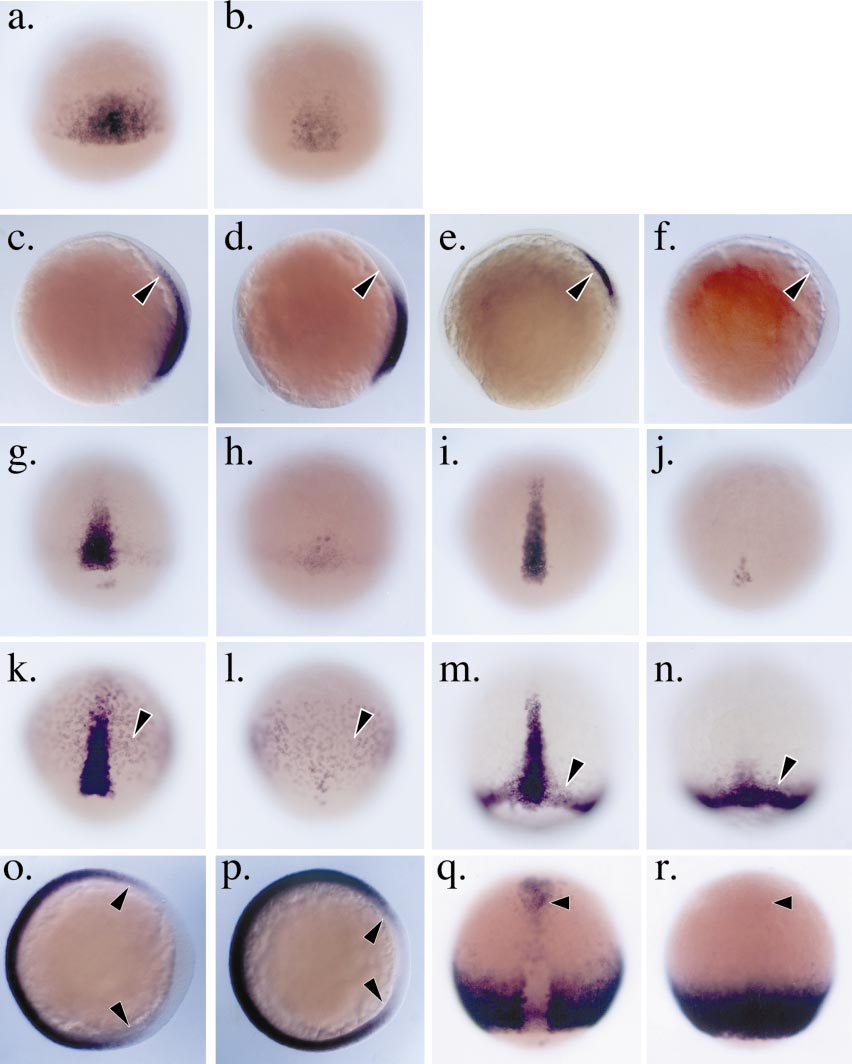Fig. 5 Impaired dorsal specification boz mutant gastrulae. Analysis marker gene expression in wild-type (a, c, e, g, i, k, m, o, q) and homozygous bozm168 mutant (b, d, f, h, j, l, n, p, r) embryos during gastrulation. Embryos in (a) and (b) are staged at the onset of gastrulation (6 hpf); embryos in (c–n) are midgastrula stage at 80% epiboly (8 hpf). All embryos are oriented with animal pole toward the top. (a), (b) and (g–n) are dorsal views, (c–f) profile with dorsal to the right. (a) chd expression at the onset of gastrulation (6 hpf) on the dorsal side of wild-type embryo. (b) In homozygous bozm168 mutant embryos chd expression is reduced at the onset of gastrulation. (c) In wild-type embryos at 80% epiboly, chd expression is detected in the mesendoderm in the nascent axis (arrowhead) as well as the lateral ectoderm (d). In homozygous bozm168 mutant embryos, chd expression is reduced or absent in the nascent axis. (e) gsc expression in the wild-type midgastrula is restricted to the cells of the anteriorly migrating prechordal plate (arrowhead). (f) In homozygous bozm168 mutant embryos, gsc expression is reduced or absent. (g, h) In wild-type embryos the expression of flh (g) and twist (i) is detected in dorsal mesendoderm cells that will later give rise to dorsal embryonic structures such as the notochord. In homozygous bozm168 mutant embryos, the dorsal midline expression of flh (h) and twist (j) is dramatically reduced. (k) axial is expressed during gastrulation in the dorsal mesendoderm as well as in the paraxial endoderm (arrowhead) in wild-type embryos. (l) In homozygous bozm168 mutant embryos, the dorsal mesendoderm expression of axial is very reduced; however, the paraxial endoderm expression does not appear affected (arrowhead). (m) In wild-type embryos, ntl is expressed both in the dorsal axial mesoderm and in the involuting ventral lateral mesoderm. (n) In homozygous bozm168 mutant embryos, the dorsal midline expression of ntl is reduced but the ventral lateral expression is unaffected (arrowhead). (o–r) Expanded ventral gene expression in boz mutant gastrulae. (o and p) The domain of eve1 expression is expanded into the dorsal region of the blastoderm in homozygous bozm168 mutant embryos. Embryos are oriented animal pole toward the viewer, with dorsal to the right. (o) In wild-type embryos at 7 hpf, eve1 expression is excluded from the dorsal region and detected in cells along the ventral two-thirds of the blastoderm circumference. (p) In homozygous bozm168 mutant embryos at 7 hpf, the eve1 expression domain extends into the dorsal region of the embryo. (q and r) The expression of tbx16/spt is altered in homozygous bozm168 mutant embryos at 80% epiboly (8 hpf). Dorsal view with the embryos oriented animal pole to the top. (q) In wild-type embryos, tbx16/spt is expressed in the ventral lateral region of the blastoderm margin and excluded from the trunk dorsal midline. tbx16/spt is also expressed in the dorsal anterior prechordal plate mesendoderm (arrowhead). (r) In homozygous bozm168 mutant embryos, tbx16/spt is detected in the trunk dorsal midline and the dorsal anterior expression domain is greatly reduced or absent.
Reprinted from Developmental Biology, 215(2), Koos, D.S. and Ho, R.K., The nieuwkoid/dharma homeobox gene is essential for bmp2b repression in the zebrafish pregastrula, 190-207, Copyright (1999) with permission from Elsevier. Full text @ Dev. Biol.

